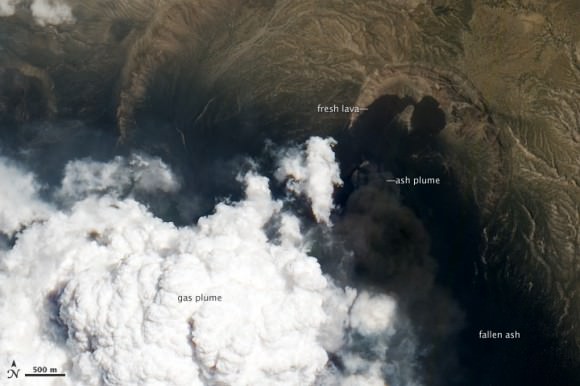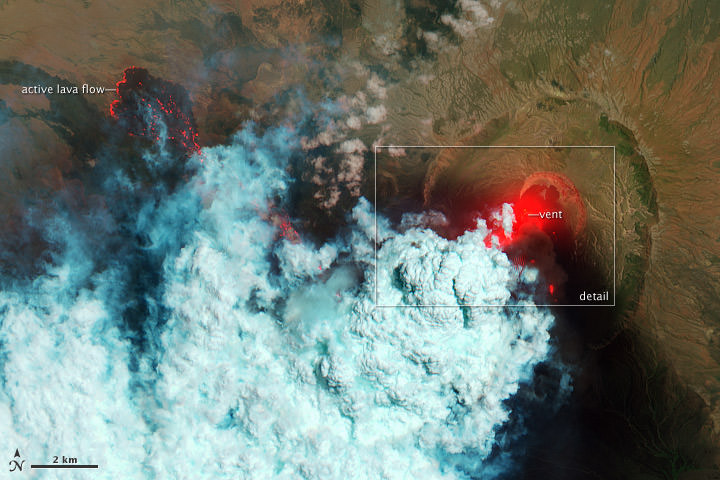[/caption]
Wow! What an amazing and detailed top-down view of an active volcano! This is the Nabro Volcano, which has been erupting since June 12, 2011. It sits in an isolated region on the border between Eritrea and Ethiopia and satellite remote sensing is currently the only reliable way to monitor the ongoing eruption, according to the NASA Earth Observatory website. The bright red portions of the false-color image (above) indicate hot surfaces. See below for a zoomed-in look. Both images were taken by the Advanced Land Imager (ALI) aboard the Earth Observing-1 (EO-1) satellite.

Robert Simmon of the NASA Earth Observatory website describes the scenes:
Hot volcanic ash glows above the vent, located in the center of Nabro’s caldera. To the west of the vent, portions of an active lava flow (particularly the front of the flow) are also hot. The speckled pattern on upstream portions of the flow are likely due to the cool, hardened crust splitting and exposing fluid lava as the flow advances. The bulbous blue-white cloud near the vent is likely composed largely of escaping water vapor that condensed as the plume rose and cooled. The whispy, cyan clouds above the lava flow are evidence of degassing from the lava.
The natural-color image (lower) shows a close-up view of the volcanic plume and eruption site. A dark ash plume rises directly above the vent, and a short, inactive (cool) lava flow partially fills the crater to the north. A gas plume, rich in water and sulfur dioxide (which contributes a blue tint to the edges of the plume) obscures the upper reaches of the active lava flow. Black ash covers the landscape south and west of Nabro.
Limited reports from the region say that at least 3,500 people and up to 9,000 that have been affected by the eruption, with at least 7 deaths caused by the erupting volcano. The ash plume has also disrupted flights in the region.
For more information see NASA’s Earth Observatory website, and BigThink


Yo Nancy, at the penultimate paragraph, it should be the verb affected, not the noun “effected”: “… and up to 9,000 that have been effected by the eruption,…”
Shouldn’t it be affected by the eruption?
If we are going to be pedantic, it should read “.. at least 3,500 and up to 9,000 people have been affected by the eruption.”.
The second “that” is superfluous and, as the numbers are both qualifying “people”, they should both precede it.
Exactly! Thanks, George!
That is what I stated in bold.
Whoops, misread what you wrote.
Nancy’s use is correct Ivan… http://dictionary.reference.com/browse/affected
Nancy’s use is correct Ivan… http://dictionary.reference.com/browse/affected
Eh? According to the link that you’ve provided, the adjective affected means “acted upon”, “influenced in a harmful way”, or “impaired” (which is what I have stated, above, should be used in that context); whereas Nancy used the term effected, which means “to produce as an effect”, “bring about”, “accomplish”, “make happen”.
Eh? According to the link that you’ve provided, the adjective affected means “acted upon”, “influenced in a harmful way”, or “impaired” (which is what I have stated, above, should be used in that context); whereas Nancy used the term effected, which means “to produce as an effect”, “bring about”, “accomplish”, “make happen”.
thex,ivan,uncle…. care factor zero. Thankyou Nancy
Why do I feel that I just watched an episode of “Sesame Street” ?
You can imagine the excitement of scientists all over the world with this remote gathering of data, that otherwise would be unobtainable due to the inaccessible location of this event. I am lucky to be old enough to have witnessed the start of Mans’ exploration of Space. And every day brings new discoveries and understanding of our place in the cosmos. This is what this site is all about. It is Not a forum for grammar geeks!
But I am learning proper English with every article! (=
And just who said this? 🙂
In formal writing, yes, starting sentences with “And”, and also “But”, should be avoided, since both terms are conjunctions – which are used to connect grammatically coordinate words, phrases, or clauses within sentences.
Instead of “And”, it is better to start a sentence with “Furthermore” or “Also”, followed by a comma. Also (see what I did there?), instead of “But”, it is better to start a sentence with “However” or “Nevertheless”, followed by a comma.